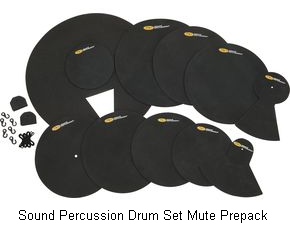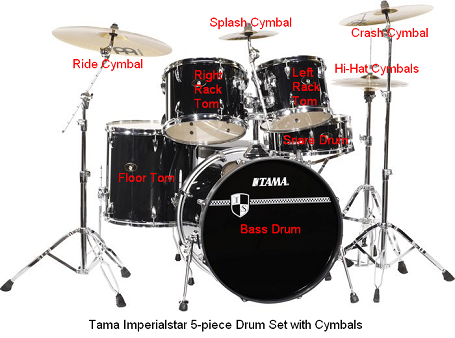A time, a place and a drum set: That’s what you need to get the most out of your practice routine. In this blog post, you’ll learn the importance of a daily practice schedule and a dedicated area to practice. You’ll also learn about the parts of a drum set. We’re following a plan to play drums in 4 weeks and this is Lesson 1 of 12. See the complete Plan by clicking here.
The most important thing that you can do when learning to play the drums is to establish a practice routine. Think about the best time of the day when you can practice for 15-30 minutes. Some people like to practice in the morning when their mind is fresh and they can make sure it gets done. Other people like to practice in the late afternoon or evening because it’s easier to focus, forget about the stress of the day and not worry about waking their housemates. Once you’ve decided on a routine, do your best to practice at the same time every day. It’s best to practice a short time each day than to save up your practice time for one or two days a week.
You’ll be surprised how easy it is to follow the routine when you get into the habit of practicing. Even if you practice at a different time one day or miss a day completely, do your best to get back to your original schedule and stick to it. Personally, I like to practice in the evening because it helps me unwind and is less disruptive to my family. Also remember that it is better to practice a short period of time each day than to save up your practice time for one or two days a week.
The second most important thing in establishing a routine is having a dedicated area for practicing the drums. If you already have a drum  set then you know the importance of having your drums set up in an area of your home where you can escape and be of minimal bother (noise-wise) to others. When I need to practice quietly but I still want the feel of a real drum set, I put Sound Percussion Drum and Cymbal Mutes on my kit. The response from these rubber pads is similar to a drum or cymbal and it allows you to practice on your drums without getting too loud. If you don’t have a drum set yet, it’s still a good idea to have your own “drum cave” even if it’s a small area in the corner of a room. Having a familiar place where you can go each day as a safe haven can help you concentrate and focus on practicing. You will need enough room to put three chairs: one to sit on and two to play on. More on that in the next section.
set then you know the importance of having your drums set up in an area of your home where you can escape and be of minimal bother (noise-wise) to others. When I need to practice quietly but I still want the feel of a real drum set, I put Sound Percussion Drum and Cymbal Mutes on my kit. The response from these rubber pads is similar to a drum or cymbal and it allows you to practice on your drums without getting too loud. If you don’t have a drum set yet, it’s still a good idea to have your own “drum cave” even if it’s a small area in the corner of a room. Having a familiar place where you can go each day as a safe haven can help you concentrate and focus on practicing. You will need enough room to put three chairs: one to sit on and two to play on. More on that in the next section.
Now that you’re familiar with the importance of a practice schedule and a place to practice, let’s take a look at the parts of a drum set. Drum sets come in all shapes and sizes. They can be as big as the monster set that Neil Peart plays in Rush or as small as the stand-up kit that Slim Jim Phantom plays in the Stray Cats.
The drum set consists of three basic components: Drums, Cymbals and Hardware.
- The most popular drum set is called a 5-piece because it’s made up of five drums: one bass drum, one snare drum and three tom-toms.
- A five-piece drum set typically has 4 cymbals: a ride cymbal, a crash cymbal and two cymbals that are on a stand called a hi-hat.
- Drum hardware consists of pedals, stands, and a drum seat (also known as a drum throne).
- The drum set is played by sitting on the drum throne, playing the drums and cymbals with your hands, and playing the bass drum and hi-hat with your feet.
The bass drum is the largest drum, sits directly on the floor and has a pedal connected to it. The bass drum is played by pressing down  on the pedal with your right foot to hit the drum. The snare drum sits between your legs on a stand. The snare is a band of spiral wires mounted on the bottom drum head to give the drum a metallic, rattle sound when it’s played. Tom-toms have a very round sound that varies in pitch depending on the size of the drums (the smaller the drum, the higher the pitch). Mounted tom-toms (or “rack toms” for short) are held up by a stand that is attached to the top of the bass drum. A floor tom-tom (or “floor tom” for short) has legs that sit directly on the floor to the right of your right leg (the leg that plays the bass drum). The left rack tom in a 5-piece drum set has the highest pitch and the floor tom has the lowest.
on the pedal with your right foot to hit the drum. The snare drum sits between your legs on a stand. The snare is a band of spiral wires mounted on the bottom drum head to give the drum a metallic, rattle sound when it’s played. Tom-toms have a very round sound that varies in pitch depending on the size of the drums (the smaller the drum, the higher the pitch). Mounted tom-toms (or “rack toms” for short) are held up by a stand that is attached to the top of the bass drum. A floor tom-tom (or “floor tom” for short) has legs that sit directly on the floor to the right of your right leg (the leg that plays the bass drum). The left rack tom in a 5-piece drum set has the highest pitch and the floor tom has the lowest.
The ride cymbal sits on a stand to the right of the bass drum just above the right rack tom and the floor tom. The crash cymbal sits on a stand to the left of the bass drum, just above the left rack tom. The hi-hat is a unique looking stand that holds two cymbals facing each other. The bottom cymbal sits on the stand without moving. The top cymbal, however, is attached to a rod that runs through the stand to a pedal that is controlled by your left foot. As you press your left foot down on the pedal, the top hi-hat cymbal is pulled down into the bottom hi-hat cymbal making a high-pitched “chick” sound.
There are many variations in setting up a drum set. What’s described here is the most common set up. Now that you know the parts of the drum set, you can quickly learn how to use the drum set to play some great beats!

I am a 23-year-old guy. I have no music background. I love listening to music and I have gone through a tough phase and feel music can be a source of peace for me. So I want to learn to play for myself first but eventually in my small church worship team.